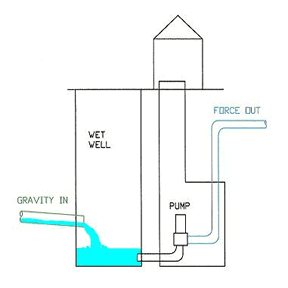
GRAVITY SEWERS
Gravity sewers are the most common method of collecting sewage. Gravity sewers have been around since early Roman times, and before. Check out http://www.sewerhistory.org.

Source: Keith Chapman, Laboratory Program Manager, Willow Lake Treatment Plant, Salem, Oregon
Let's begin in your house. All of your sinks, toilets, bathtubs, showers, washing machines, etc. are connected to a drain pipe which collects what we refer to as sewage or wastewater.
Water enters your house in pipes under some kind of pressure.
Sewage leaves your house without pressure and must flow by "gravity".
Gravity is what keeps you from floating into space, allows you to walk around
and also allows us to collect sewage. The sewage flows down the drain pipes
and leaves your house, and is connected to a pipe outside your house sometimes
referred to as your lateral connection to the sewer.
This pipe runs from your house to the SCCLSD's sewer main usually located in the street or street right of way. This lateral pipe is usually 4 inches in diameter and must slope to the main sewer. Slope is a term to refer to the ratio of the vertical drop compared to the length of the pipe. The minimum slope for sewer laterals is 2% or roughly a quarter inch per foot. That means for every foot of pipe, you drop a quarter of an inch, so for 100 feet of pipe, you drop 100 quarter inches or 25 inches or just over 2 feet, thus the 2 percent.
Enough Math, we know it must flow downhill.
The sewage leaves your house through your lateral pipe, and ends up in the sewer main out in the street. This pipe then flows downhill to another pipe, which flows downhill to another pipe, which flows downhill to another pipe, etc, etc, all the while these pipes are getting larger and larger in diameter so they can handle more sewage. As these pipes get larger in diameter, they don't need as much slope to move the sewage, but they still have to have some slope to move the sewage.
So, if we keep flowing downhill, how deep does it get? If we were to try and have one pipe flow from our farthest point, Midway Park, which is approximately eleven and a half miles or 60000 feet from our treatment plant, we would need to be over 100 feet deep. That won't work. What we do instead is use a series of pumping stations along the way. Pumping stations collect the sewage in a large tank or wetwell, and pump it down the road to either another pumping station or a gravity sewer line. Pumps allow us to move the sewage uphill to a point where we can begin to flow by gravity again.

SCCLSD uses six pumping stations to collect and transport sewage on the North side of Chautauqua Lake and three pumping stations on the South side. There are several small pumping stations used throughout the SCCLSD to collect from small areas.